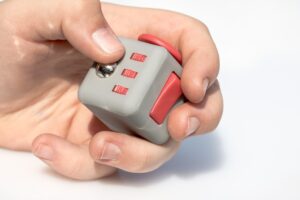Imagine you’ve had a tough day at school or work. What do you imagine yourself doing once you get home? Your answer probably depends on how intense your emotions are at that time. All emotions have an associated urge with it. When our emotions are at a distressing level, we can begin to lose sight of acting on these urges may not be in the interest of our long-term goals. *cough cough* Me when I shut the kitchen cabinet a bit too rough when feeling angry or overwhelmed. Doing things like this typically doesn’t help us feel better in the long run, and can actually make things worse for us. So, what can you do instead? One option is to use the Distress Tolerance skill of Self-Soothing with your 5 senses. This skill is all about stimulating your 5 senses. Doing this can shift your attention from the emotion and begin to reduce its intensity.
To make your kit find a box, bag or basket and begin collecting things that help you get through a difficult moment. Consider the size of your kit. There may be value in making it small enough that you can take it with you on the go. Your kit making will take some preparation. Putting in the time now to collect these items will aide you in being able to immediately begin using this skill rather than using precious cognitive energy to think or and go find these items in time of distress. Your future self is going to thank you!
Below is a list of examples of items you may decide to include in your kit. This, of course, is not an exhaustive list. The important thing is to fill your kit with things that YOU find helpful.
Hearing:
Create a few different playlists, one with your all-time favorite songs, one that energize and motivate you, and one that is calming and helps you relax. You may include podcasts that cover topics that grab your attention quickly. Do you like nature sounds? If you do, include a few lists of your top favorites. Have a friend record a series of jokes so you can have a good laugh.

Smell:
Our sense of smell is our most primitive sense. It is the one that will most readily evoke memories and different emotions. Include a hand lotion, essentials oils, a small candle, a sample size of perfume. Write yourself a note to make a cup of coffee or bake chocolate chip cookies and soak up the aroma.
Taste:
Throw in a pack of mints, gum, sour candy, chocolate, pop rock candy…. anything you like! The importance here is that whatever you use, you slow yourself down enough to actually taste the item. Don’t be like me and devour a handful of Hersey kisses without even noticing!

Touch:
Add in different fidget toys such as a stress ball, putty, fidget spinner. Add in a piece of fabric that you like to touch like velvet. Write yourself a note to change into comfortable clothes, use a weighed blanket, to use a heating pad. Find a way to remind yourself to massage your temples or shoulders to help reduce tension.
Vision:
Either you or someone important to you write encouraging statements such as you’ve done hard things before. You can do it again” or “you won’t feel like this forever.” Add photos of pets, nature, places you would like to visit. Make a list of your favorite television shows or movies to prompt you to que those up.
Emotions can get the best of us sometimes. Having a kit on hand of things that help soothe and calm you can be an effective way of not only regulating your emotions but also help you not engage in behaviors that ultimately make the situation worse. Your future self will thank you for taking the few minutes it takes to make your self-soothing kit!
About the Author
Desirae Allen (she/her), Psy.D., is a licensed clinical psychologist that specializes in dialectical behavior therapy. Desirae works with teens and adults, creating a compassionate and judgement-free space, where clients can find wellness and recovery. Desirae believes that DBT can make a long-term difference in people’s lives, and she strives to work collaboratively with her clients to provide adherent DBT. Click Here to learn more about Desirae’s experience and therapeutic style.

